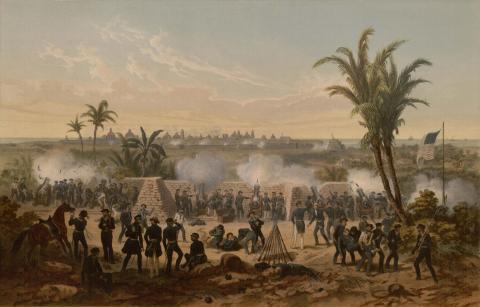Biographies | Broadsides | Correspondence | Diaries & Journals | Newspapers | Images | Maps
The opening of a southern front presented enormous logistical challenges for the Polk administration. Congress had failed to provide new regiments in time to take part in the operation, so a large portion of Zachary Taylor's Army of Occupation stationed in towns below the Rio Grande had to be diverted to open up the new front. In Washington, U.S. Army Quartermaster General Thomas S. Jesup oversaw the massive effort, shipping some fifteen thousand men, weapons and other equipment from the United States and northern Mexico to Lobos Island, an island midway between Tampico and Vera Cruz, which had been selected as a rendezvous point for the invasion.
On March 3, 1847, the combined force sailed to Antón Lizardo, twelve miles south of Vera Cruz. Aided by Commodore David E. Conner's Home Squadron, Scott landed an army of 10,000 men on the beaches south of Vera Cruz on March 9, 1847. Meeting no opposition, they quickly established positions around the city, which was defended by 3,000 Mexican troops under General Juan Morales, as well as another 1,000 troops inside the harbor fortress of San Juan de Ulúa.Scott offered to allow the civilian population to leave the city, but Morales declined, and on March 22, the bombardment began. The U.S. warships in the harbor also opened fire. Two days later, bigger U.S. Navy guns were brought ashore, inflicting even greater damage to the city. As casualties mounted under the withering barrage, General Morales resigned, turning over his position to General Juan Landero. Under pressure from civic leaders and foreign consuls in the city, Landero sought terms on March 25. Three days later the city's defenders and the garrison at San Juan de Ulúa surrendered. Although Scott's forces suffered only 70 casualties, perhaps as many as 400 Veracruzanos had been killed during the bombardment.Vera Cruz remained under U.S. control throughout the war and served as a point of supply and reinforcements for the invading army, which would soon begin its march up the National Road to Mexico City.

